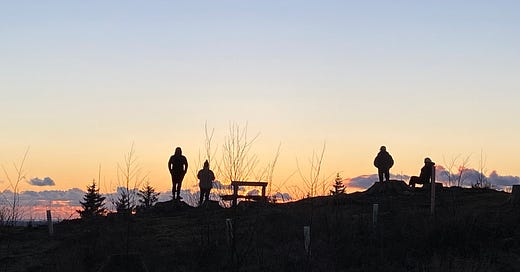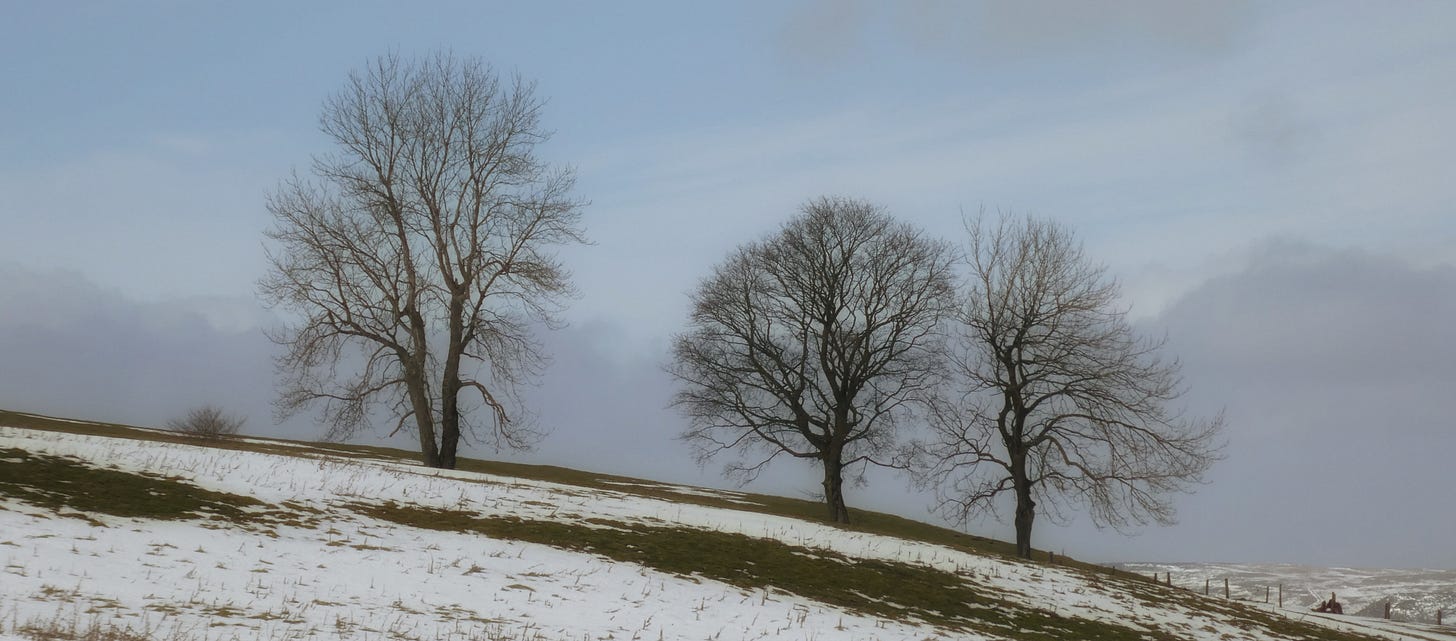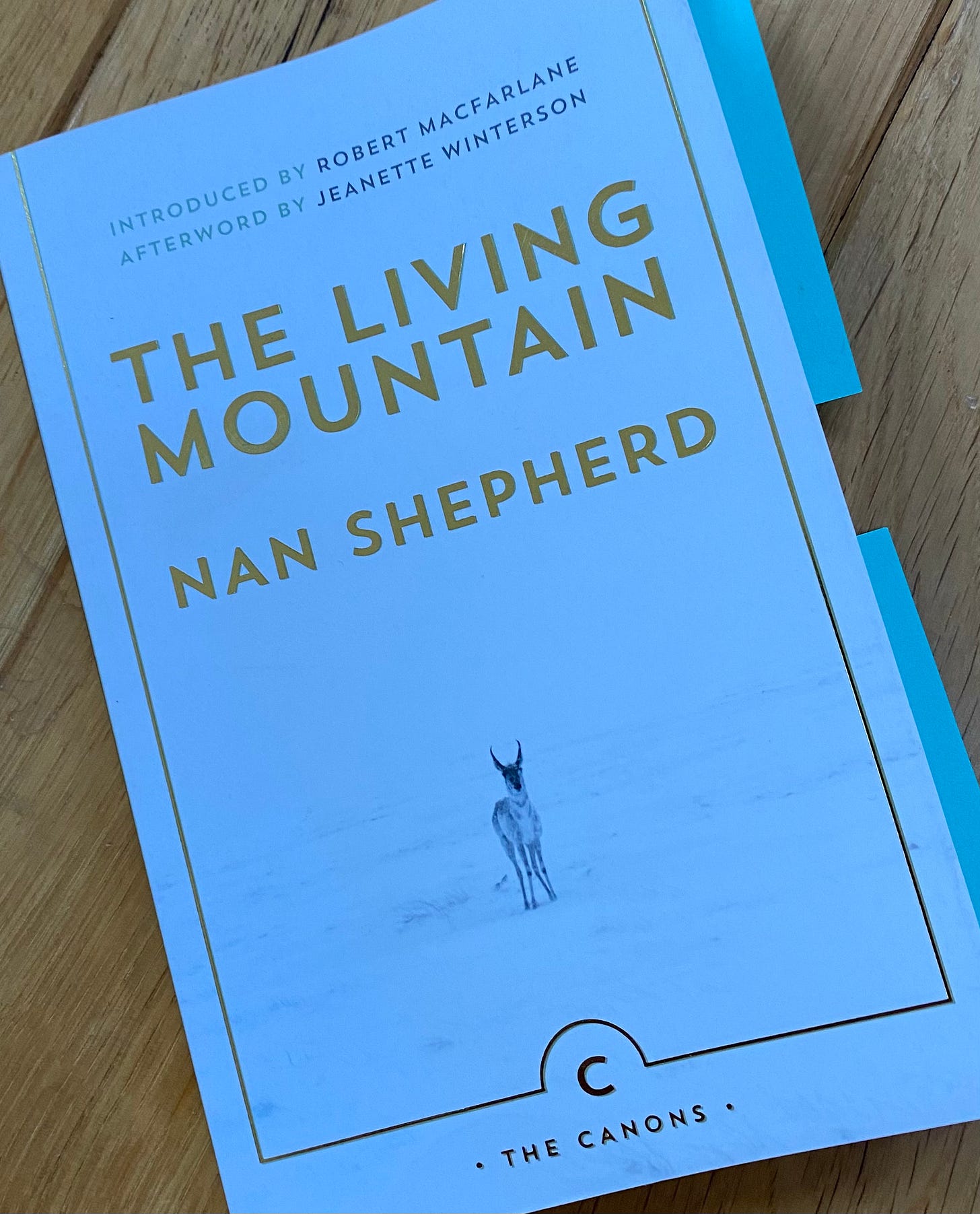Bringing Nature Inside
... thoughts on the beauty and power of mindfulness combined with biophilia
Hello and thank you for reading this edition of Regen/Notes1
“Through the practice of mindfulness, we can learn to see the world with new eyes, and understand our place in the web of life.” - Thich Nhat Hanh
Introduction
OK, this article - is starting from a different place than first planned - is the continuation of thoughts around Biophilia, Biophilic Design and Mindfulness. (see ‘thinking biophilia intro here)
Last week I wrote a description of eco-anxiety for another publication …
Eco-anxiety is a feeling of stress, fear, or overwhelm caused by the ongoing environmental crisis and its impact on the planet and humanity, often accompanied by the sense of being unable to make or influence meaningful action to address the problem. Eco-anxiety also arises from the challenge of imagining how a sought after world built on love, caring and regenerative principles could come about, given that our cultural commercial and increasingly digital environment all too often reinforces the opposite.
… influenced by the words of Robin Wall Kimmerer in Braiding Sweetgrass who hits the message so well …
Cautionary stories of the consequences of taking too much are ubiquitous in Native cultures, but it’s hard to recall a single one in English. Perhaps this helps to explain why we seem to be caught in a trap of overconsumption, which is as destructive to ourselves as to those we consume. Robin Wall Kimmerer
… and deeper reflecting on the word digital, how we have been sucked into the current digital, social media, AI and ChatGPT world, further separating us from the natural world, all playing into our eco-anxiety. (In addition to any general social media-digital-anxiety many face)
And then lands Charles Eisenstein's brilliant substack post, on the Robot that was once human, escaping from the digital world into nature. I will let you read that post in full here - but the description of how the digital world has increased our estrangement is just brilliant …
His secret is that he was once a man, a breathing, pulsing, feeling man. He had forgotten his own secret though. He had forgotten how one by one, he replaced his organs with mechanisms. He forgot how he replaced his wild thoughts with formulas. He forgot how he replaced his qualities with quantities, his intuition with predictions, his choices with compulsions, his conscience with permission, his intelligence with algorithms, his songs with downloads, his adventures with simulations, and his aliveness with preservation.As he did this, year upon year, his humanness retreated deeper, and deeper still, until it was a wisp, a whisper, an error in the code, a contradiction in the math. The man within waited in a secret hiding place, lost and lonely in the vast contraption he had become.
How then can we, like Eistenstien’s Robot, escape from the trap of separation - to rebalance our formulas with wild thoughts, our quantities with qualities, our preservations with aliveness.
“We often forget that we are nature, and that nature is not something separate from us. So when we say that we have lost our connection to nature, we’ve lost our connection to ourselves.” Andy Goldsworthy
During the pandemic, many (re)discovered the rejuvenating effects of nature right on our doorsteps, within the allowed one hour outside, myself included. It seems we were all then motivated to increase our time in nature, with many also starting a more structured mindfulness meditation routine. The blend was impactful.
“finding the faraway nearby” is a very apt marketing expression from the impressive Alpkit (outdoor equipment) - yet not only are we finding the faraway on our doorstep we are now finding the faraway inside.
Mindfulness and Biophilia, both increasing in popularity over recent years, have similar aims - to ground and to connect, to find the time and space to reflect on our relationship with nature and to reflect on our separation from the natural world. Yet then the question I am asking myself when I read about or visit biophilic designed spaces, is how does this relate to mindfulness, address and foster reciprocity and close the separation we may feel.
How does biophilic design in its current practice enable mindfulness, enable a threshold crossing, and give or encourage the space and time for mindful reflection?
“Biophilia and Biophilic Design is about our values and ethical responsibility for the care and sustainability of the natural world” Stephen Kellert
the Human Inner Environment Impact on the Built Environment
FutuREstorative explored the issue of mindfulness in the built environment as a key concept in personal rethinking, changing our mindsets and approaching sustainability with a different perspective and language. Anne Parker saw the disconnect between sustainable projects and unsustainable practices, the Human Inner Environment Impact on the Built Environment Why is it even in biophilic offices, within architect practices and built environment practices that embrace biophilic design in their projects individuals still suffer from burnout and anxiety?
OK, I see your amazing new project. Your eco-sustainable, living- materials, planet-friendly building. It beams out at me from the journals – your PR people have done a great job. It shines, it beams, it blows my socks off. Now I’m looking at one of your project managers. And I look again, a little more closely. Now the light is not so bright, now the beam is not so strong. I am looking at fractured thoughts, disturbed sleep, skipped meals. I’m looking at ever-present simmering levels of irritability, of intolerance, of impatience, of short attention spans, of reduced focus, a shadow of pessimism, ongoing anxiety and a mind that never stops. Anne Parker, in FutuREstorative2
Regenerative Mindfulness
“The practice of mindfulness is not just about being in the present moment, but about being present to the needs of the world.” - Joanna Macy
Regenerative mindfulness can be viewed as a holistic approach to mindfulness that emphasises the interconnectedness of all living things and the role that individuals and communities can play in promoting ecological, social, and economic regeneration. It allows the time and space for reflection, increases self-awareness and self-regulation, and attention to the interconnectedness of all living things.
Within the Regenerative Playbook3 we place regenerative as not just something we do but rather something that we are or we become. In taking the time, and indeed giving, the time and space for reflection. Josie Warden in the forward comments that regenerative means not only working to change out there but also to change in here, our own mindsets and behaviours and those of our organisations
Reports from the Intergovernmental Panel on Climate Change (IPCC) have highlighted the need for 'inner transition' and the potential of meditation to encourage lower carbon and climate aware lifestyles.
Christine de Figueres, who led the landmark 2015 Paris climate accord negotiations found her practice of mindfulness and deep listening was the key to the successful agreement that led to the Paris 1.5 agreement.
Giles Hutchins in 'Leading by Nature' talks of the threshold-crossing in worldview/mindset. This is essential, and yet sometimes overlooked in our excitement to use the word ‘regenerative’. Regenerative is not simply ‘net positive’, nor a trade-off of negative and positive impacts. Regenerative is about deepening our sense of connection with inner-outer nature so that we work more in harmony with life.
“It is kinship not technical potential that will prevent the sixth major extinction event” David Hinton Wild Minds, Wild Earth
Mindful Walking
“The sum of the whole is this: walk and be happy; walk and be healthy,” Charles Dickens.
Mindful walking is a form of meditation that involves paying attention to the present moment while walking. Typically done in quiet, natural settings, paying attention to one’s breath, body sensations, and surroundings. The goal is to be fully present and aware of the experience of walking rather than allowing the mind to wander.
We will explore the importance of being active in nature in a third part, but, whilst the concepts of forest bathing and immersion in forests are wonderful, the simple act of walking is a powerful form of mindfulness. Something that has been emphasised time and time again by writers through past generations, from Wordsworth, Muir, Dickens, Thoreau, Thich Nhat Hanh, Solnit, and Macfarlane to name a few. But I wanted to introduce (or perhaps re-introduce in this context) the book that shaped my thoughts and relationship with both mindfulness, biophilia and being in nature …
The Living Mountain
I came to mindful walking through reading Nan Shepherd’s book “The Living Mountain”, which triggered a switch from my outdoor activity, from an obsession with reaching summits and ticking hills or routes climbed on a checklist, to one of ‘going into the mountain’ spending time in nature, taking time to notice and enjoy the whole living environment.
"To be alone on a mountain is to be yourself, to discover yourself, and to discover that this self is not something which can be discovered. It is the discovery that there is no discovery. It is the recognition of the non-existence of the self. It is the realization that there is no realization. It is to be aware of the awareness. It is to be conscious of the consciousness." Nan Shepherd.
The Living Mountain is an extraordinary book, written by Shepherd in the 1940’s but kept in her bureau drawer until published in the 1977 that explores the author’s experiences and reflections on the Cairngorm Mountains in Scotland. "The Living Mountain" is significant for its unique perspective, fresh ecological sensitivity, philosophical depth, and literary style, now recognised as a classic work of nature writing.
It is Shepherd's emphasis on the importance of the imagination, the role of perception in shaping our understanding of the world, and the interconnectedness of all things that has inspired many readers to reflect on their own experiences and develop a deeper understanding of themselves and the world around them.
Not only did it inspire me, but it also gave aspiration to weave other dimensions into my work, and life. To weave, back in the 1990s, project and environmental management with a love of being in mountains and nature, which led to naming my business after a local hill (Fairsnape Fell), discovering the living building challenge, and bringing mindful and regenerative practice into consultancy and advocacy.
"Yet often the mountain gives itself most completely when I have no destination, when I reach nowhere in particular, but have gone out merely to be with the mountain as one visits a friend with no intention but to be with him."
This lovely quote emphasises Shepherd's belief that the true value of being in nature lies not in achieving any particular goal or destination, but in simply being present and fully engaged with the natural world. By approaching nature with a sense of openness and curiosity, without any preconceptions or expectations, we can deepen our connection to the world around us and experience its beauty and wonder more profoundly.
The Living Mountain embodies Biophilia (as in love of life) by focusing on sensory and emotional experiences of the natural world, emphasising the interconnectedness of all life forms and the importance of kinship with natural ecosystems.
Shepherd encourages readers to cultivate a sense of wonder and awe for the natural world, which can be seen as an expression of the love of life. Her lyrical and poetic descriptions of the Cairngorms and exploration of the philosophical and spiritual dimensions of the natural world inspire a re-connect with nature on a deeper level, fostering a sense of reverence and respect for all forms of life.
Perhaps influenced by her love of nature and her desire to live in harmony with the natural world, Shepherd was a student in philosophy, Zen and Taoism that plays through The Living Mountain. Zen emphasising meditation and enlightenment, the importance of living in the present moment and Taoism emphasises living in harmony with the natural world.
And so to relate this to Biophilic Design - We need to learn from thinking such as the Living Mountain that inspires that connection with nature on a deeper level, that fosters a sense of reverence and respect for all forms of life.
There is a connection between the idea of "going into the mountain" from "The Living Mountain" and the concept of active Biophilic Design. The book invites readers to reconsider the natural world as a living and dynamic entity that demands active engagement, rather than passive observation. In the same way, biophilic design should seek to create spaces that invite and encourage active engagement on the part of the inhabitants, creating a willingness to explore and engage with the natural world on its terms, rather than imposing our own will upon it
I feel this is an expression of the powerful biophilic principle of "prospect and refuge" emphasising the importance of creating spaces that offer both a sense of openness and of shelter and protection. In this way, the idea of "going into the mountain" can be seen as a call to active engagement with the natural world through the built environment, creating spaces that are responsive, adaptable, and life-affirming.
So what does Biophilic Design look like after the Covid lockdown era? It certainly still looks a lot like Kellert’s attributes and 14 Patterns, but these were pre-covid and now with a different perspective on nature and the growing mindfulness practices we have found, it is starting to look a little different.
The next part in this thinking biophilia series will explore being in nature, noticing nature and moving in nature is good for dampening the amygdala. And maybe passively experiencing biophilic design elements of nature (the plants, the textures, the light) may not be.
And, or if you enjoyed or found this edition of value, you can simply buy a coffee. Thank you.
Previous articles on Regen/Notes can be explored here - and the best of 2022 can be read here- ENJOY.
“FutuREstorative, Working Towards a New Sustainability” by Martin Brown (2016)
The Regenerative Playbook - https://bit.ly/regenplaybook






